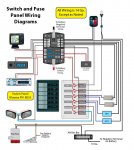Twhjelmgren28
Seaman
- Joined
- May 31, 2016
- Messages
- 71
Hey there,
So I recently purchased a boat from my grandfather and I have a couple questions on getting the electronics setup how I would like them. First of all, I assume it makes sense to keep all of the accessories on a deep cycle battery and isolate the starting battery for starting only. I've noticed that the starting battery isn't maintaining enough juice to start consistently (hmm...I wonder why - see below). Currently the boat is setup as follows:
Starting Battery:
-Ignition / starter
-Radio (recently added myself) - wired through accessory switch
-Lights - wired to switch
-Blower - wired to switch
-Bilge - wired to switch
Deep Cycle:
-Trolling Motor
-Depth Finder
Question 1: Does it make sense to put everything other than the ignition/starter onto the deep cycle battery?
Question 2: As I noted above, all of the accessories on the starting battery are wired to switches on the dash. For some reason, these accessories will ONLY work if they are wired onto the starting battery - my grandpa has several cables including the ignition cables taped together that go onto the starting battery - how do I get the switches wired over to the deep cycle - example - my radio (wired to accessory switch) will only work when coupled and attached with the ignition cables and a few other unknown cables. Are the switches wired positive / negative to the battery - as in, are they one of these other unknown cables but not the ignition/starting cables? Or are the switches wired through/with the ignition cables. Essentially, I'm trying to get the accessory switches to run on the deep cycle not the starter. It doesn't help that my grandpa is the king of jerry-rigging and there are cables and duct tape running every which way!
Sorry for all the info and thank you very much for any help!
So I recently purchased a boat from my grandfather and I have a couple questions on getting the electronics setup how I would like them. First of all, I assume it makes sense to keep all of the accessories on a deep cycle battery and isolate the starting battery for starting only. I've noticed that the starting battery isn't maintaining enough juice to start consistently (hmm...I wonder why - see below). Currently the boat is setup as follows:
Starting Battery:
-Ignition / starter
-Radio (recently added myself) - wired through accessory switch
-Lights - wired to switch
-Blower - wired to switch
-Bilge - wired to switch
Deep Cycle:
-Trolling Motor
-Depth Finder
Question 1: Does it make sense to put everything other than the ignition/starter onto the deep cycle battery?
Question 2: As I noted above, all of the accessories on the starting battery are wired to switches on the dash. For some reason, these accessories will ONLY work if they are wired onto the starting battery - my grandpa has several cables including the ignition cables taped together that go onto the starting battery - how do I get the switches wired over to the deep cycle - example - my radio (wired to accessory switch) will only work when coupled and attached with the ignition cables and a few other unknown cables. Are the switches wired positive / negative to the battery - as in, are they one of these other unknown cables but not the ignition/starting cables? Or are the switches wired through/with the ignition cables. Essentially, I'm trying to get the accessory switches to run on the deep cycle not the starter. It doesn't help that my grandpa is the king of jerry-rigging and there are cables and duct tape running every which way!
Sorry for all the info and thank you very much for any help!




















